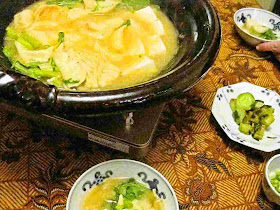<Ingredients>
5 cm daikon radish
1/2-2/3 tofu
Small bunch kinsai Chinese celery
Large handful arugula
Handful enoki mushrooms
Small handful (100 g) hakusai napa cabbage kimchi
600 cc chicken stock
300 cc kobudashi (water + 2 pieces 5 cm square kombu kelp)
100 cc sake
1 tsp ami no shiokara salted baby shrimp (optional)
2 tbsp miso
1 green onion (thinly sliced for garnish, not in photo)
<Directions>
1.
Soak kombu in water for at least 10 minutes (preferably at least 30 minutes).
2.
Cut daikon into 8 mm-thick half-moon shape (first cut into two lengthwise, then slice thickly crosswise).
Cut Chinese celery into 3-4 cm.
Remove root ends of enoki.
Cut tofu into smaller pieces (2 cm thick and 5cm square).
Roughly chop kimchi.
3.
Put chicken stock and daikon, cover, and cook.
Remove kombu as liquid comes to a simmer.
Add sake, and continue cooking until daikon is soft.
4.
Meanwhile, take some liquid from pot, and soften miso.
5.
Add kimchi, ami no shiokara and gyoza.
When broth heats up again, add tofu.
Add miso. Taste, and adjust as necessary (add more miso or a small amount of soy sauce).
Add enoki and stem parts of Chinese celery.
Take to the table, and continue cooking on portable stove.
Add arugula and leafy parts of Chinese celery.
Eat hot with sliced green onions.
<Notes>
- For Process 1 above, partly because I did not have time to wait, I put water and kombu in the clay pot and put it on low heat (clay pot takes time to heat up, so the kombu gradually releases umami flavor by the time water is heated).
- Any gyoza or jiaozi works. When you use frozen ones, do not defrost them -- put directly into the broth.
- Any vegetable and mushroom works. No item here is a "must-have" goodie. Check your fridge.
- The pot can be taken to the portable stove on the table any time during the cooking process. I usually take it toward the end, because cooking on the kitchen stove is easier when there are many ingredients and it also saves fuel for the portable stove.
- Do not put fast-cooking ingredients, such as leafy vegetables and mushrooms, all at once. Put a small amount in the pot at a time, and add more as they are eaten. This way, they will not be overcooked.
- If chicken stock is not available, simply use more water or substitute dashi of your choice.
- Ami no shiokara gives a complex flavor to the broth; a tiny amount goes a long way. It is salty, so do not overuse. If not available, simply forget about it.














No comments:
Post a Comment